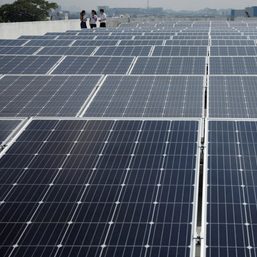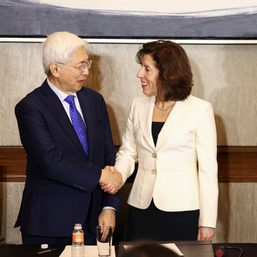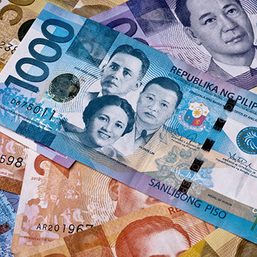SUMMARY
This is AI generated summarization, which may have errors. For context, always refer to the full article.
![[OPINION] Peddling a plunder fund](https://www.rappler.com/tachyon/2023/07/TL-MIF-plunder-fund-revised-july-10-2023.jpg)
This is not on the economic pros and cons of the Maharlika Investment Fund (MIF). Instead, this focuses on those who parented it, the parties who peddled it, and those who will immediately gain from it.
Apparently, there is a triad hellbent on a panacea presumably for an impending global contraction brought about by high inflation and the war in Ukraine – premises cited by Ferdinand Marcos Jr.
Let us analyze those.
According to the London-based Center for Economics and Business Research, 2023 will be characterized by a global contraction. The International Monetary Fund predicts that global growth will fall to 2.9% while the European Union is already in a de facto recession.
For possible MIF investors remnant hope is pinned on regional performances. But those differ depending on how linked economies are to China or the United States. For instance, Bangladesh and India may buck the downward trend.
China is expected to grow at 1.1%, but the US will hardly move the needle beyond 0.6%. Can both risk investing in an ill-defined MIF that’s prone to plunder?
While Marcos cited Ukraine as a principal impetus, his finance secretary, MIF’s lead horn blower, described its direct effects as collateral damage akin to being struck by a “ricocheting bullet.”
So both presumably sought novel funding sources. But note the MIF’s effective misappropriation from one pocket to another amid a deficit.
There is no subtlety when numbers bloat from billions to trillions. Our primary deficit, the total less interest payments, was P299.4 billion in 2019. That number is now P1.1 trillion. Any misappropriation on the heels of a worsened deficit degrades balance sheet quality and impoverishes.
Note the current numbers. Nominal gross domestic product (GDP) per capita among ASEAN is $5,812. Ours is $3,905, the lowest among Indonesia, Thailand, Singapore, Vietnam, and Malaysia. Why, pray tell?
Consider this: after Marcos’s first year our Corruption Perception Index (CPI) hardly changed from that under former president Rodrigo Duterte. In a working paper by the Leibniz Institute for Economic Research at the University of Munich, globally, real per capita GDP decreases almost 20% when CPI increases by one standard deviation. The coefficient of correlation was computed at 70.52%. The high correlation and the low standard deviation led to as much as a 17% to 20% decrease in per capita GDP. The study notes that this inverse relationship is especially pronounced in autocracies afflicted with low-quality governance.
That makes sense. Duterte enabled the Marcos administration. The baton was passed.
So were officials recycled to peddle the MIF.
Corruption as criteria
This behooves using the propensity for corruption as criteria. This is important. The Munich study shows investors hesitate to invest in corruption-prevalent economies. Now apply that to Maharlika’s three-headed Ghidorah.
The first is comprised of paid mainstream and social media mouthpieces, broadsheets and online hacks contracted to hard-sell the MIF. Their lack of depth and details, coupled with inconsistencies in their understanding of the evolving sovereign fund that subtly transformed into a vanilla-flavored ‘’source-anywhere’’ investment corporation belies the public relations DNA of their advocacy.
For example, one PR campaign repeats MIF’s ambitious return of 8.6% like a mantra. Unfortunately, absent specific projects, such returns cannot be determined. Especially, where these are invested in Marcos’s “Build Better More” as infrastructure returns require directly attributable revenue streams. Emerging market listed infrastructure returns after a decade tend to be around 2.4%. Imagine returns for unlisted infrastructure. Even economies with excess oil revenues barely earn over 6% inside a decade.
Note also, where one opinion described the Government Pension Fund of Norway as having ‘’achieved impressive returns over the years with an annualized return of 6.1% since its inception.’’ Calling it a ‘’Successful precedent’’ the same PR operator headlined the two-year Indonesian Investment Authority (IIA) as the model for the MIF, echoing a congressman’s claim that the IIA earned $23 billion.
One, Norway’s “impressive” wealth fund lost $164 billion last year, a negative return of over 14%.
Two, fact-checker FactsFirstPH determined the cited Indonesian $23 billion earnings as false.
In a milieu inundated by falsehoods, some questionable media organizations soon realized the power of misinformation and have morphed from news organizations to political power brokers.
Unfortunately, their duplicity is adequately rewarded.
Compared to the PR hard sell, the more substantive discourses on the MIF reveal a second peddler’s cabal with a tendency to use the MIF as a money laundering device.
Analyze the MIF’s Sections 10 and 12 that allow inclusions from offshore instruments and secretly stashed funds. Here, we quote tax expert Raymond Abrea. “The Maharlika Investment Fund, in its current state, is prone to corruption and money laundering. There are no other people [interested in] investing other than those who want to launder money. The fact that it is not clear [creates] an opportunity for those who want to take advantage of us to make money and get away with it. That’s exactly what Maharlika is offering. There are a lot of immunities or exemptions. You’re actually attracting those who want to take advantage of it.”
As for MIF’s operators, each ultimately politically appointed, note statutory “Get-out-of-jail” cards where prescriptive periods are abbreviated, while jail time and monetary penalties are made affordable. For example, the fine for MIF fraud is about the price of a single high-end SUV, or two back-up vehicles.
As for the third group in the triad, they benefit immediately. Comprised of political dynasties, cousins and cronies, there is no need for them to wait for MIF’s ballyhooed 8.6%, much less approximate Indonesia’s effective 2.15% return on $6.5 billion.
The MIF allows for direct capital market investments in handpicked equities. Its menu is shortlisted to power, real estate, infrastructure (rail, road, and airports) and logistics (port development).
Now recall the top-of-mind corporations in these categories. The implicit subsidies influence listed stock prices to skyrocket enough to earn quick windfalls from margin trading.
Sadly, the MIF is fait accompli. Resistance is futile. – Rappler.com
Dean de la Paz is a former investment banker and managing director of a New Jersey-based power company operating in the Philippines. He is the chairman of the board of a renewable energy company and is a retired business policy, finance, and mathematics professor. He collects Godzilla figures and antique tin robots.
Add a comment
How does this make you feel?
![[ANALYSIS] What they don’t tell you about the rule of law and corruption in PH](https://www.rappler.com/tachyon/2023/06/what-they-dont-tell-you-june-13-2023.jpg?fit=449%2C449)

![[ANALYSIS] Search for stocks that continue to sizzle](https://www.rappler.com/tachyon/2024/04/search-stocks-that-sizzle-April-5-2024.jpg?resize=257%2C257&crop_strategy=attention)



![[In This Economy] Is the Philippines quietly getting richer?](https://www.rappler.com/tachyon/2024/04/20240426-Philippines-quietly-getting-richer.jpg?resize=257%2C257&crop=194px%2C0px%2C720px%2C720px)
![[In This Economy] A counter-rejoinder in the economic charter change debate](https://www.rappler.com/tachyon/2024/04/TL-counter-rejoinder-apr-20-2024.jpg?resize=257%2C257&crop=267px%2C0px%2C720px%2C720px)
![[Vantage Point] Joey Salceda says 8% GDP growth attainable](https://www.rappler.com/tachyon/2024/04/tl-salceda-gdp-growth-04192024.jpg?resize=257%2C257&crop_strategy=attention)
![[ANALYSIS] A new advocacy in race to financial literacy](https://www.rappler.com/tachyon/2024/04/advocacy-race-financial-literacy-April-19-2024.jpg?resize=257%2C257&crop_strategy=attention)

There are no comments yet. Add your comment to start the conversation.